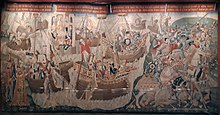Goffar the Pict

Goffar (
Historia Regum Britanniae

In the myths surrounding
After a battle at the mouth of the
This idea probably comes from
Rowland Wymer points out the brutality in this account of Brutus' killing of Goffar's people.[1]
The first battle, including Goffar, is vividly portrayed in a c. 1475 tapestry now held in the Cathedral of the Savior of Zaragoza's museum.[2][3]
British tradition
Peter Langtoft's Chronicle (written before his death around 1305) has Goffar as "Gofforre" (or Goffre, Goffor, or Goffore), king of "Payters" (Poitiers). It says that Brutus arrived in Aquitaine, which they called "Paytewe" (Poitou) at the time. It gives the name of Subardus as "Suard" (or "Sward"), and Imbertus as Ymbert, who is Goffar's men's "chieftain by common agreement".[6]
John Hardyng's Chronicle (1437) has Goffar as "Goffore" as king of "Aquitayne that Guyen now is" (Guyenne), who fights with Brutus and Corineus hand to hand before retreating to "Gaule ... that now is Fraunce".[7]
John Rastell's The Pastyme of People (1529) mentions Goffar (under the name "Copharius") as a prince of "Gallia now callyd Guian" (Guyenne), as part of a very condensed version of the Brutus story.[9]
Locrine (1595), a play attributed to Shakespeare, mentions "Goffarius, the arm strong King of Gauls, / And all the borders of great Aquitaine". It gives Goffarius a brother, Gathelus, who had been fought by Corineus.[10]
French tradition
La Décoration du Pays et Duché de Touraine (1541) by Thibault Lespleigney also includes Goffar as "Grofarius Pictus". It cites Bouchet's Annales.[15]
Name
In Horn et Rimenhild, a twelfth century French version of the story of King Horn, one of the King of Dublin's two sons is called Guffer. William Henry Schofield gives Goffarius Pictus as a potential source of this name.[16]
In the fourteenth century play
References
- JSTOR 41556874.
- ^ Hunter, George Leland (1925). The Practical Book of Tapestries. p. 87.
- ^ "Brutus' expedition to Aquitaine, c. 1475". Getty Research Institute.
- ^ Wace (1836). Le Roux de Lincy, Antoine (ed.). Le Roman de Brut. Vol. 1. Rouen. pp. 39–40.
- S2CID 160558869.
- ^ Langtoft, Peter (1866). Wright, Thomas (ed.). The Chronicle of Pierre de Langtoft. pp. 14–21.
- ^ Peverley, Sarah; Simpson, James, eds. (2015). John Hardyng, Chronicle: Edited from British Library MS Lansdowne 204: Volume 1. pp. 56–57.
- ^ Fabyan, Robert (1811). Ellis, Henry (ed.). The New Chronicles of England and France. p. 10.
- ^ Rastell, John (1811). Dibdin, Thomas Frognall (ed.). The Pastime of People. p. 87.
- ^
- ^ White, Richard (1597). Comitis Palatini Historiarum Libri. pp. 134, 151–152.
- JSTOR 40958447.
- ^ Bouchet, Jean (1557). Les Annales d'Aquitaine. p. 5.
- ISBN 978-0-19-866125-2.
- ^ Lepleigney, Thibault (1861). Galitzin, Augustin (ed.). La Décoration du Pays et Duché de Touraine. pp. 7–8.
- JSTOR 456475.
- ^ Bliss, Jane (2008). Naming and Namelessness in Medieval Romance. p. 60.
